Monday May 15, 2017
Somalia’s capital is buzzing: estate agents thrive and it recently hosted a TedX conference. But Mogadishu is facing a fresh challenge as drought forces half a million people to seek aid. Jason Burke visits a growing camp on the outskirts
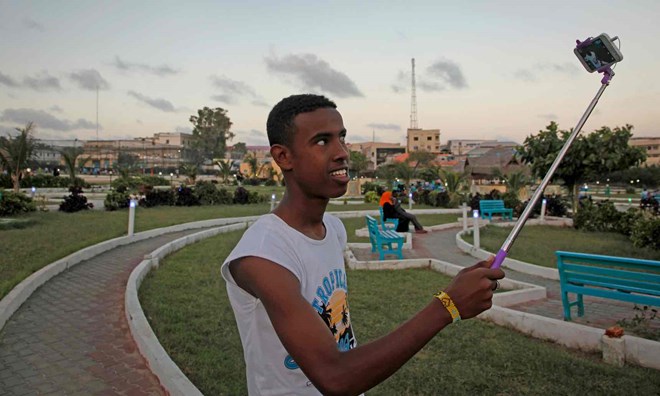
A man takes a selfie in Mogadishu’s new Peace Park. Photograph: Farah Abdi Warsameh/AP
Friday afternoon and the light is low across the waves breaking on the long shore. Behind the pocked and pitted seafront promenade, hundreds of children play football among their shattered homes. This, the ruins of the old port area of Somalia’s Mogadishu, is the war-torn city of the news stories, books and films.
Less than a 10 minute drive away down a newly rebuilt double highway, the scene is very different: hundreds of young men and women stroll along the narrow band of sand left by the high tide; they paddle, swim and drink coffee or soft drinks in cafes. An ancient stretch limousine, hired out for weddings, noses through the traffic. Rickshaw drivers shout for fares.
“There are two sides to Mogadishu. The horrible side … and then there is this,” says Abdirahman Omar Osman Yarisow, Somalia’s newly appointed information minister, who is sitting at a table in the Beachview hotel on the famous Lido watching the relaxed Friday afternoon crowds.Somalia’s capital is buzzing: estate agents thrive and it recently hosted a TedX conference. But Mogadishu is facing a fresh challenge as drought forces half a million people to seek aid. Jason Burke visits a growing camp on the outskirts

A man takes a selfie in Mogadishu’s new Peace Park. Photograph: Farah Abdi Warsameh/AP
Friday afternoon and the light is low across the waves breaking on the long shore. Behind the pocked and pitted seafront promenade, hundreds of children play football among their shattered homes. This, the ruins of the old port area of Somalia’s Mogadishu, is the war-torn city of the news stories, books and films.
Less than a 10 minute drive away down a newly rebuilt double highway, the scene is very different: hundreds of young men and women stroll along the narrow band of sand left by the high tide; they paddle, swim and drink coffee or soft drinks in cafes. An ancient stretch limousine, hired out for weddings, noses through the traffic. Rickshaw drivers shout for fares.
There are few cities with contrasts as stark as those of Mogadishu. It is six years since the Islamic militants of al-Shabaab withdrew from streets battered by 20 years of incessant warfare. But daily violence is a reminder that the group remains a formidable threat if it is restricted to rural zones. Mortar shells kill children. Aid convoys are hit by roadside bombs. Politicians are shot dead in the street. Gunmen raid military camps and hotels while suicide bombers attack seafood restaurants on the Lido.
“The place next door got hit but nobody is bothered. We’re always busy. We don’t worry,” says Abdi Fata Jama, the 29-year-old manager of the Beachview hotel.
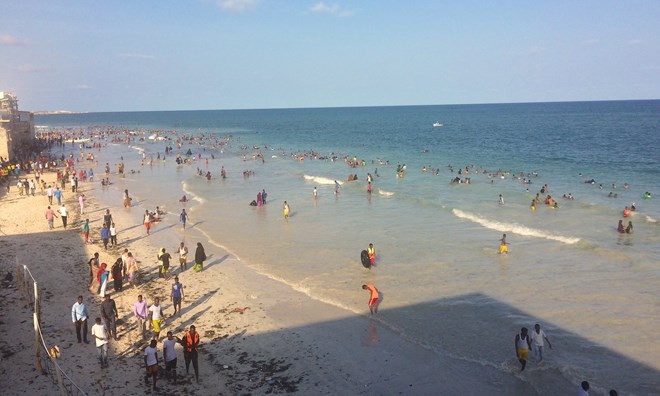
Relaxed crowds enjoy Mogadishu’s Lido. Photograph: Jason Burke for the Guardian
Despite the ongoing violence, the economy is growing, hundreds of expatriates are returning from the west or African nations, scores of colleges are opening to cater for the phenomenally young population and there is growing investment from the diaspora. Estate agents thrive. A two-storey house can cost nearly £100,000. Mogadishu just hosted a TedX conference.
In the centre of the city, a new Peace Park equipped with a bouncy castle, swings, a football pitch and benches is thronged at weekends and evenings when temperatures dip.
“Somalis are very brave, very resilient. No one can change when they are to die. So they ignore the problems … and the city is booming and moving on,” says Yarisow.
‘The situation is very fragile’
But Mogadishu, already one of the fastest growing cities in the world, is about to undergo another massive transformation that will bring another huge challenge.
Somalia’s arid countryside is facing famine – a consequence of the worst drought for 40 years and the ongoing insurgency. More than half a million people are already on the move, seeking food, water, shelter and medical care. Around 100,000 have already reached Mogadishu, with more arriving every day. Aid officials fear the numbers will rise if rains do not come next month, with a million people potentially seeking sanctuary in Somalia’s cities by the year’s end.
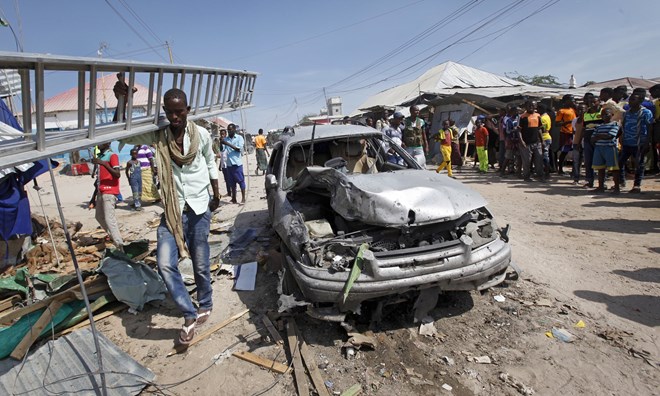
The aftermath of a blast in a market in Mogadishu in February, which killed more than a dozen people. Photograph: Farah Abdi Warsameh/AP
Such numbers may overwhelm efforts by the government and the international community. Save the Children, the international charity, are scaling up operations in Somalia to provide basic assistance to over 2 million people including 70,000 in Mogadishu. “The situation is very fragile,” says Hassan Noor, the country director. United Nations officials are planning a major distribution.
At one camp on the outskirts of Mogadishu, the scale of the problem is clear. Already home to around 6,000 people, the cramped lot of tents and shelters had received more than 700 new arrivals in two days earlier this month. Food provided by Save the Children is running out.
“We can’t cope. We’re short of shelter, staff for cooking, fuel, everything. These people have borrowed, begged or sold to get the funds to get here. They arrive with nothing. And they are weak. Some of the kids are dying on the road,” says Zara Ali Mahamud, the 29-year-old camp manager.
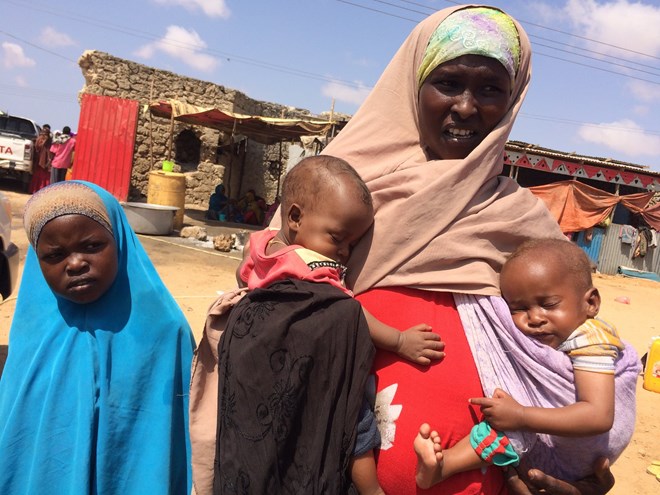
Barwako Aden Berda, who walked for three days to reach Mogadishu with her five-month-old twins and daughters aged eight and 10. Photograph: Jason Burke for the Guardian
Cholera and similar diseases are killing thousands in rural Somalia, and those fleeing remote villages can spread infection in cities too; 19 cases have been registered in the camp.
“There will be thousands [of people] coming in the next weeks. We need help. If it doesn’t come, it is simple: people will die,” says Mahamud.
The relief effort also suffers from the endemic violence. Al-Shabaab systematically targets international humanitarian workers. A convoy from the World Food Programme was hit by a roadside bomb near the camp’s entrance, a day after the Guardian’s visit.
The influx could upset the fragile process of reconstruction in Mogadishu, placing huge strains on the few basic services available to its 2 million inhabitants, and posing a long-term security threat.
Officials admit the areas around Mogadishu are a “no man’s land”, and say it is impossible for police or government officials to enter at least two neighbourhoods of the city known to be strongholds of support for al-Shabaab. Even the heavily defended international airport – where thousands of diplomats, United Nations staff and regional troops from the African Union stabilisation force are based – is frequently attacked.
Mogadishu is already struggling to absorb a previous influx from the countryside. Hundreds of thousands have moved to the city in recent years, many driven from their villages by the last famine in 2011. Most live in vast settlements, surviving on aid and odd jobs. Conditions are tough, and there are concerns that with huge numbers of young, unemployed, rootless men, such camps are fertile ground for extremism.
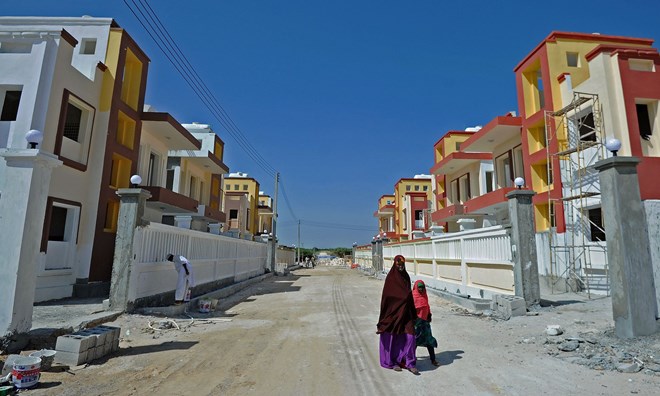
People walk through Daru Salaam city, a new housing estate in northern Mogadishu. Photograph: Mohamed Abdiwahab/AFP/Getty Images
However, few contemplate returning home soon.
“There is no livestock, no food, so it’s very difficult. We would need a bulldozer to clear our land of trees and bush now. So we’ll stay here,” says 43-year-old Faduma Yusuf Gadi, from a small village nearly 250 miles from Mogadishu, who has lived with her six children in Shabelle camp for four years.
Experts say the example of other urban centres in Africa suggests the rapid growth of Mogadishu and other Somali cities could spur economic transformation – but only with careful management and a new infusion of international aid.
“The massive shift into urban areas can be an opportunity. It is the way of the future, it is what needs to be done to build a different economy, a different country. But that needs huge investment,” says Michael Keating, the UN special representative in Somalia.
The current appeal for funds to meet immediate humanitarian needs in Somalia aims to raise nearly $1bn (£770m). Keating believes a similar sum will be needed to cope with the consequences of the current crisis.
Yarisow, the information minister, grew up in Mogadishu. He returned in 2008 after many years in London, with much of the embattled city under the authority of al-Shabaab. That, he says, was “a bad time”.
“So much has changed. There is a huge difference. Now is the best time. We know the international community will help us, but basically it is up to Somalis to do this, and to do it on our own,” he says.

No comments:
Post a Comment